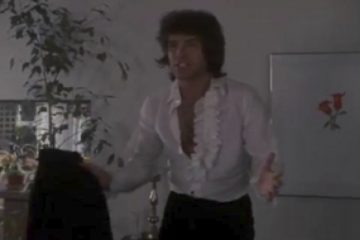The satirical film, Shampoo (Ashby, 1975) examines the shallow existence of those who have achieved, and those who strive for, the lifestyle of the Hollywood nouveaux riches. George, a hairdresser, craves stability in business and domestically, but his colourful private life undermines his aspirations; he is his own worst enemy. The casting of Beatty was significant in establishing the character of George, as their personal lives were very similar; Beatty was known for his many fleeting, high profile romances. Ashby’s work balances and juxtaposes humour and melancholy. Through the introduction of a timely parallel, the dishonourable activities of Richard Nixon serve as a cultural metaphor for the aspirations of the film’s protagonists. Two stereotypical perceptions, particularly of that era, are debunked, namely, that women are monogamous, and the latent, homophobic perception, that a man who is a ladies’ hairdresser must be gay. There is a strong leitmotif of gender roles. One critic pulls no punches, stating that ‘[i]t’s a savage satire that sets its sights on hypocrisy, superficiality, and sexual mores’ (Brunson, 2019).

At the beginning of the scene, the red sports car which is being driven at a reckless speed, is a conventional visual metaphor for male potency and passion, particularly as it stands out against the somewhat bland backdrop. Indeed, after the vehicle comes to a halt, it is the bold image of the car, rather than the protagonists, which dominate the frame (Fig. 1). In contrast, there is a nearly off-screen glimpse of George’s motorbike which, although it does not project the status symbol of the car, is his thrusting modus operandi for rapid navigation of the city, in pursuit of glamorous women. The camera next tracks George’s girlfriend, the provocatively dressed Jill (Goldie Hawn) and there is a shot framing her from George’s perspective thus foreshadowing the subsequent immediate tension between the two protagonists as she descends, in order to reach the apartment. Her slow, downward approach, combined with the narrowness of the staircase, provides dual metaphorical symbolism of her sinking and constrained relationship. The audience predicts the inevitability of the womaniser breaking the heart of yet another female conquest. George’s attire is de rigueur, that of the overtly stereotypical playboy, with his ubiquitous, chest-revealing, fully open frilly shirt, chain, watch and flamboyant hairstyle.

The apartment appears cramped, containing an excess of paraphernalia, representing their stifled relationship. The kinematics of George’s body movements are prominently framed, thus, when he sits, holding his head down, and exhibits demonstrative, somewhat over-exaggerated, hand movements, he projects a sense of visual, if insincere, hyperbole as he tries to justify his behaviour. The physical spacing between the two characters provides a metaphor for their emotional interaction; indeed, at some points they are set well apart. The décor of the room is not kitschy and the paintings on the wall are not lavish or erotic, however, in particular through the avant garde work which features prominently, there is a deference to art, exhibiting some semblance of culture. The meaning of the ‘1653’ artwork is unclear – and probably intentionally so – constituting a further visual metaphor for doubt and uncertainty in the couple’s relationship. When Jill throws the ring, she expresses justifiable, visceral anger towards the philandering George, and she also uses this item as an icon of the marriage partnership, thereby foreshadowing the fact that the union between the two is, ultimately, not likely to be. Contrarily and ironically, the audience witnesses a picture of a double red rose, a symbol of the deeper desire for settled monogamy, a love of one person for the other (Fig. 2). The apartment contains several plants which, of course, require care and attention, a further visual allusion to the nurturing which is required for a relationship to blossom. When George is framed with a commanding view of the city, the audience is invited to question whether he is being projected as having dominion over its female inhabitants (Fig. 3).

Almost everything about Shampoo is predicated on glitz, for which hairstyles serve as an obvious visual metaphor. Nevertheless, despite the nature of the characters’ superficial lifestyles, it is perhaps a simplistic interpretation of George’s disposition to perceive him as the archetypal lothario. Indeed, Pauline Kael identifies him differently, stating that ‘[m]aking love to a beautiful woman is an aesthetic thing with him, and making her look beautiful is an act of love for him’ (qtd. in Lennon, 2005).
Janet Maslin writes ‘The picture is unsettling because it dares accept sexual promiscuity as a given and treat its concomitant problems seriously’, to which was added ‘Quite an accomplishment for a comedy’ (qtd. in Peary, 1991). In sum, the mise-en-scène of this sequence successfully projects the extremes of stereotypical masculinity and femininity.
References
Brunson, M. “Review: Shampoo” Filmfrenzy.com. 17 Oct. 2018. Web. 02 Mar. 2022
Lennon, E. “The Edge of Melancholy: Shampoo”. Sense of Cinema. Oct. 2005. Web. 02 Mar. 2022
Peary, D., (1991) “Review: Shampoo”. Criterion.com. 23 Sept. 1991. Web. 03 Mar. 2022.

Leanna Hilda Miller is a first year Film and English student. She has a passion for the cinematic adaptation of novels, theatre and writing poetry. She hopes to become a film or theatre critic. .
Please obtain permission before redistributing. Copyright © 2022 Leanna Hilda Miller